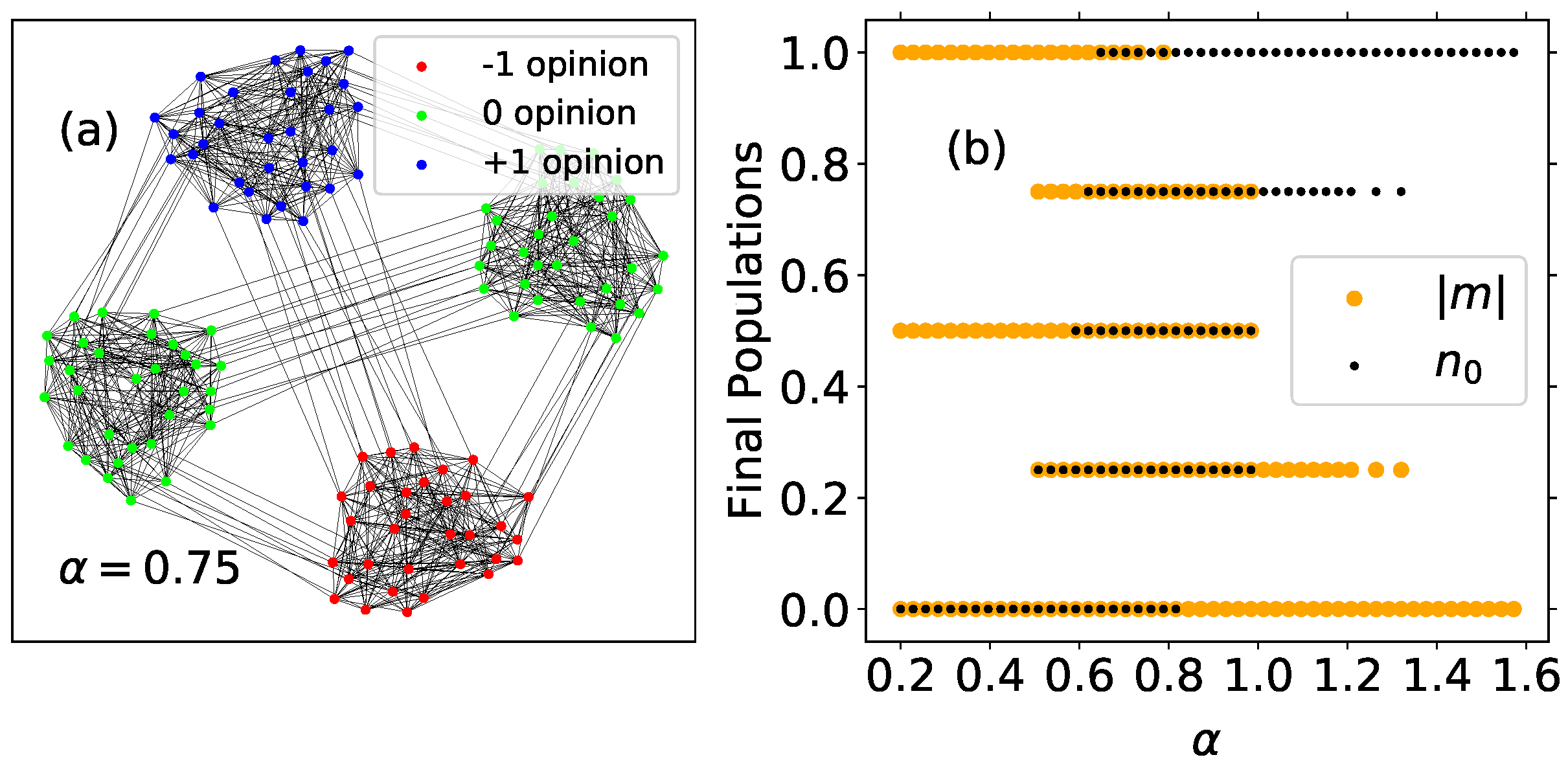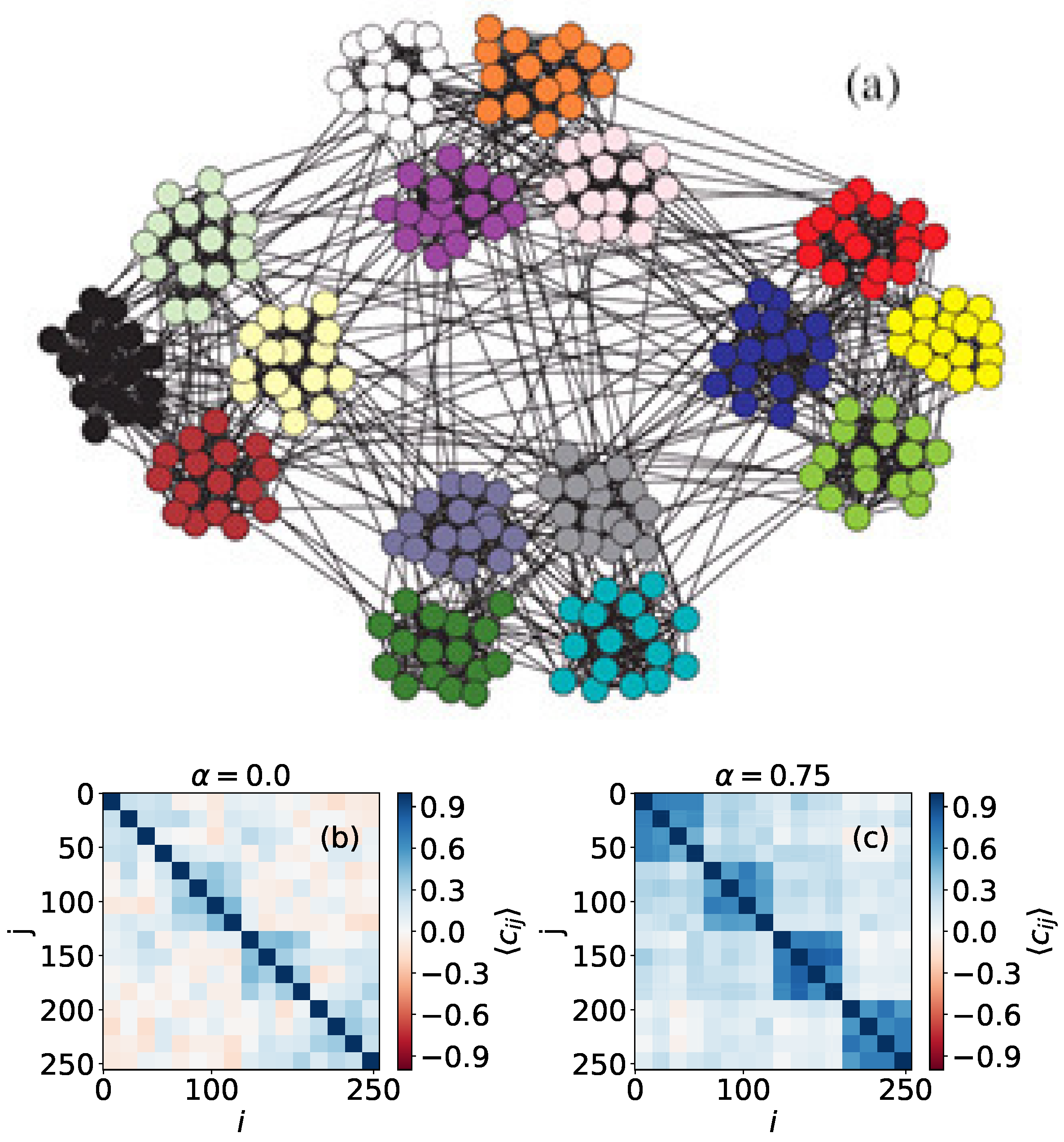Three-State Opinion Model on Complex Topologies
Abstract
:1. Introduction
2. Materials and Methods
- ; positive opinion/rightist;
- ; neutral opinion/centrist;
- ; negative opinion/leftist,
3. Results and Discussion
3.1. Previous Results
3.2. Modular Networks
- , corresponding to a system divided into two communities, each one holding a different extremist opinion.
- that is obtained when three communities hold the same polarized opinion and the fourth holds the opposite one.
- , if by chance the system reaches the global consensus.
3.3. Real Networks
4. Conclusions
Author Contributions
Funding
Institutional Review Board Statement
Data Availability Statement
Acknowledgments
Conflicts of Interest
Abbreviations
| MMC | Metropolis Monte Carlo |
Appendix A
| Algorithm A1 Calculate correlations |
|
|
| Algorithm A2 Sorting links |
|
|
References
- Castellano, C.; Fortunato, S.; Loreto, V. Statistical physics of social dynamics. Rev. Mod. Phys. 2009, 81, 591–646. [Google Scholar] [CrossRef] [Green Version]
- Galam, S. Sociophysics; Springer: New York, NY, USA, 2012. [Google Scholar]
- Galam, S. Modeling the forming of public opinion: An approach from sociophysics. Glob. Econ. Rev. 2013, 18, 2–11. [Google Scholar] [CrossRef]
- Kutner, R.; Ausloos, M.; Grech, D.; Matteo, T.D.; Schinckus, C.; Stanley, H.E. Econophysics and sociophysics. Physica A 2019, 516, 240–253. [Google Scholar] [CrossRef] [Green Version]
- Holley, R.A.; Liggett, T.M. Ergodic Theorems for Weakly Interacting Infinite Systems and the Voter Model. Ann. Probab. 1975, 3, 643–663. [Google Scholar] [CrossRef]
- Vazquez, F.; Redner, S. Ultimate fate of constrained voters. J. Phys. A 2004, 37, 8479–8494. [Google Scholar] [CrossRef]
- Deffuant, G.; Neau, D.; Amblard, F.; Weisbuch, G. Mixing beliefs among interacting agents. Adv. Compl. Syst. 2000, 3, 87–98. [Google Scholar] [CrossRef] [Green Version]
- Deffuant, G.; Amblard, F.; Weisbuch, G.; Faure, T. How can extremism prevail? A study based on the relative agreement interaction model. J. Artif. Soc. Soc. Simul. 2002, 5. [Google Scholar]
- Hegselmann, R.; Krause, U. Opinion dynamics and bounded confidence, models, analysis and simulation. J. Artif. Soc. Soc. Simul. 2002, 5. [Google Scholar]
- Weisbuch, G. Bounded confidence and social networks. Eur. Phys. J. B 2004, 38, 339–343. [Google Scholar] [CrossRef] [Green Version]
- Lazarsfeld, P.F.; Merton, R.K. Friendship as a social process: A substantive and methodological analysis. Freedom Control. Mod. Soc. 1954, 18, 18–66. [Google Scholar]
- Weidlich, W. The statistical description of polarization phenomena in society. Br. J. Math. Stat. Psychol. 1971, 24, 251–266. [Google Scholar] [CrossRef]
- Kossinets, G.; Watts, D.J. Origins of homophily in an evolving social network. Am. J. Sociol. 2009, 115, 591–646. [Google Scholar] [CrossRef]
- Galam, S. Rational group decision-making: A random field ising model at T = 0. Physica A 1997, 238, 66–80. [Google Scholar] [CrossRef]
- Herrero, C.P. Ising model in small-world networks. Phys. Rev. E 2002, 65, 066110. [Google Scholar] [CrossRef] [Green Version]
- Galam, S.; Martins, A. Two-dimensional Ising transition through a technique from two-state opinion-dynamics models. Phys. Rev. E 2015, 91, 012–108. [Google Scholar] [CrossRef]
- Li, L.; Fan, Y.; Zeng, A.; Di, Z. Binary opinion dynamics on signed networks based on Ising model. Physica A 2019, 525, 433–442. [Google Scholar] [CrossRef]
- Dasgupta, S.; Pan, R.K.; Sinha, S. Phase of ising spins on modular networks analogous to social polarization. Phys. Rev. E 2009, 80, 025101. [Google Scholar] [CrossRef] [Green Version]
- Hurtado-Marín, V.A.; Agudelo-Giraldo, J.D.; Robledo, S.; Restrepo-Parra, E. Analysis of dynamic networks based on the ising model for the case of study of co-authorship of scientific articles. Sci. Rep. 2021, 11, 5721. [Google Scholar] [CrossRef]
- Guimerà, R.; Sales-Pardo, M.; Amaral, L.A.N. Modularity from fluctuations in random graphs and complex networks. Phys. Rev. E 2004, 70, 025101. [Google Scholar] [CrossRef] [Green Version]
- Witoelar, A.; Roudi, Y. Neural network reconstruction using kinetic ising models with memory. BMC Neurosci. 2011, 12, P274. [Google Scholar] [CrossRef] [Green Version]
- Das, T.K.; Abeyasinghe, P.M.; Crone, J.S.; Sosnowski, A.; Laureys, S.; Owen, A.M.; Soddu, A. Highlighting the structure-function relationship of the brain with the ising model and graph theory. BioMed Res. Int. 2014, 2014, 237898. [Google Scholar] [CrossRef] [PubMed] [Green Version]
- Marinazzo, D.; Pellicoro, M.; Wu, G.; Angelini, L.; Cortés, J.M.; Stramaglia, S. Information transfer and criticality in the ising model on the human connectome. PLoS ONE 2014, 9, e93616. [Google Scholar] [CrossRef] [PubMed]
- Suchecki, K.; Eguíluz, V.M.; Miguel, M. Voter model dynamics in complex networks: Role of dimensionality, disorder, and degree distribution. Phys. Rev. E 2005, 72, 036132. [Google Scholar] [CrossRef] [PubMed]
- Reichardt, J.; Bornholdt, S. Detecting fuzzy community structures in complex networks with a potts model. Phys. Rev. Lett. 2004, 93, 218701. [Google Scholar] [CrossRef] [PubMed] [Green Version]
- Li, H.-J.; Wang, Y.-C.; Wu, L.-Y.; Liu, Z.-P.; Chen, L.; Zhang, X.-S. Community structure detection based on Potts model and network’s spectral characterization. EPL 2012, 97, 48005. [Google Scholar] [CrossRef]
- Vazquez, F.; Krapivsky, P.L.; Redner, S. Constrained opinion dynamics: Freezing and slow evolution. J. Phys. A 2003, 36, L61–L68. [Google Scholar] [CrossRef] [Green Version]
- Yang, Y.-H. Blume–emery–griffiths dynamics in social networks. Phys. Procedia 2010, 3, 1839–1844. [Google Scholar] [CrossRef] [Green Version]
- Fernandez, M.A.; Korutcheva, E.; de la Rubia, F.J. A 3-states magnetic model of binary decisions in sociophysics. Physica A 2016, 462, 603–618. [Google Scholar] [CrossRef] [Green Version]
- Castelló, X.; Eguíluz, V.M.; Miguel, M.S. Ordering dynamics with two non-excluding options: Bilingualism in language competition. New J. Phys. 2006, 8, 308. [Google Scholar] [CrossRef]
- Ferri, I.; Díaz-Guilera, A.; Palassini, M. Equilibrium and dynamics of a three-state opinion model. arXiv 2022. Available online: https://arxiv.org/abs/2210.03054 (accessed on 6 October 2022).
- Candia, J. Non-equilibrium opinion spreading on 2d small-world networks. J. Stat. Mech. Theory Exp. 2007, 2007, P09001. [Google Scholar] [CrossRef]
- Kaufman, M.; Diep, H.T.; Kaufman, S. Sociophysics analysis of multi-group conflicts. Entropy 2020, 22, 214. [Google Scholar] [CrossRef] [PubMed] [Green Version]
- Fortunato, S. Community detection in graphs. Phys. Rep. 2010, 486, 75–174. [Google Scholar] [CrossRef] [Green Version]
- Danon, L.; Díaz-Guilera, A.; Duch, J.; Arenas, A. Comparing community structure identification. J. Stat. Mech. Theory Exp. 2005, 2005, P09008. [Google Scholar] [CrossRef] [Green Version]
- Newman, M.E.J.; Girvan, M. Finding and evaluating community structure in networks. Phys. Rev. E 2004, 69, 026113. [Google Scholar] [CrossRef] [PubMed] [Green Version]
- Arenas, A.; Díaz-Guilera, A.; Pérez-Vicente, C.J. Synchronization reveals topological scales in complex networks. Phys. Rev. Lett. 2006, 96, 114102. [Google Scholar] [CrossRef] [PubMed] [Green Version]
- Son, S.-W.; Jeong, H.; Noh, J. Random field ising model and community structure in complex networks. Eur. Phys. J. B 2005, 50, 431–437. [Google Scholar] [CrossRef] [Green Version]
- Chen, H.; Hou, Z. Optimal modularity for nucleation in a network-organized ising model. Phys. Rev. E 2011, 83, 046124. [Google Scholar] [CrossRef] [Green Version]
- Zhao, F.; Ye, M.; Huang, S.-L. Exact recovery of stochastic block model by ising model. Entropy 2021, 23, 65. [Google Scholar] [CrossRef]
- Arenas, A.; Fernández, A.; Gómez, S. Analysis of the structure of complex networks at different resolution levels. New J. Phys. 2008, 10, 053039. [Google Scholar] [CrossRef] [Green Version]
- Svenkeson, A.; Swami, A. Reaching consensus by allowing moments of indecision. Sci. Rep. 2015, 5, 14839. [Google Scholar] [CrossRef]








| ER z4 | #yotambien | #martarovira | #nochebuena | #BA z2 | |
|---|---|---|---|---|---|
| N | 2000 | 2408 | 29110 | 20022 | BA z2 |
| z | 4 | 2.8 | 3.67 | 2.45 | 2 |
| C | 0 | 0.12 | 0.08 | 0.01 | 0 |
| L | 5.58 | 3.1 | 4.04 | 4.14 | 8.04 |
| A | 0 | −0.28 | −0.27 | −0.33 | −0.13 |
| 0.52 | 0.62 | 0.65 | 0.76 | 0.94 | |
| 1.0 | 0.70 | 0.47 | 0.32 | 0.19 |
Publisher’s Note: MDPI stays neutral with regard to jurisdictional claims in published maps and institutional affiliations. |
© 2022 by the authors. Licensee MDPI, Basel, Switzerland. This article is an open access article distributed under the terms and conditions of the Creative Commons Attribution (CC BY) license (https://creativecommons.org/licenses/by/4.0/).
Share and Cite
Ferri, I.; Pérez-Vicente, C.; Palassini, M.; Díaz-Guilera, A. Three-State Opinion Model on Complex Topologies. Entropy 2022, 24, 1627. https://doi.org/10.3390/e24111627
Ferri I, Pérez-Vicente C, Palassini M, Díaz-Guilera A. Three-State Opinion Model on Complex Topologies. Entropy. 2022; 24(11):1627. https://doi.org/10.3390/e24111627
Chicago/Turabian StyleFerri, Irene, Conrad Pérez-Vicente, Matteo Palassini, and Albert Díaz-Guilera. 2022. "Three-State Opinion Model on Complex Topologies" Entropy 24, no. 11: 1627. https://doi.org/10.3390/e24111627






